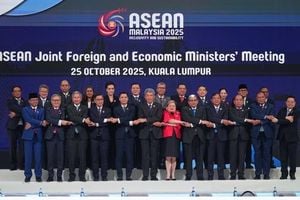Researchers have made strides toward enhancing the efficiency of electrochemical reactions important for energy generation by circumventing traditional barriers imposed by linear scaling relationships (LSRs). This discovery focuses on the oxygen evolution reaction (OER), which plays a key role in green technologies such as water splitting and hydrogen production.
The study presents how dynamic structural regulation of active sites on catalysts can significantly boost reaction performance. By developing a molecular nickel-iron catalyst through innovative methods, the research team revealed transformative insights with promising applications.
Linear scaling relationships describe the correlation of adsorption energies for reactive intermediates on single-site catalysts, often leading to sub-optimal catalytic performance. Given the intricacies of the OER, characterized by multiple intermediates such as OH, O, and *OOH, optimizing these reactions on traditional catalysts remains challenging.
To tackle these limitations, the researchers constructed the Ni-Fe2 molecular complex catalyst via electrochemical activation. This involved using low-coordinate nickel single atom precursors and incorporating minute quantities of iron ions—just 1 ppm—during the activation. This careful process enabled the dynamic evolution of the active sites, allowing the interactions between nickel and iron to govern catalytic efficiency.
Advanced methods, including operando X-ray absorption fine structure (XAFS) measurements and density functional theory (DFT) simulations, were employed to validate the extraordinary performance of the catalyst. The findings indicate considerable improvement, with overpotential values dropping significantly during regular tests.
One major breakthrough observed was the cooperative interaction between the dynamically changing coordination of nickel and the adjacent iron, which together reduced the energy barriers associated with key reaction steps within the OER process. Such dual-site cooperation proved pivotal for breaking the inherent scaling relationships, enhancing the effectiveness of oxygen evolution significantly.
Operando XAFS studies demonstrated how the nickel site fundamentally reshapes during the catalytic process, leading to new electronic structures optimal for facilitating reactions. The dynamic nature of this interaction allows catalytic cycles to progress smoothly by lowering the activation energies needed for O-H bond cleavage and O-O bond formation.
Notably, the new catalyst surpassed existing state-of-the-art systems concerning efficiency and productivity, achieving higher turnover frequencies (TOFs) and showing remarkable stability during countless catalytic cycles. This performance is significant since the combination of high activity and resilience is rare among catalysts.
The promising outcomes not only advance our knowledge of molecular water oxidation catalysts but also provide fresh paradigms for overcoming limitations imposed by classic scaling relationships. With the growing interest in sustainable technology, this research offers exciting potential for the practical application of advanced electrocatalytic systems.
Currently, researchers are excited about the future directions of this work, emphasizing the necessity for continued exploration of bimetallic catalysts and the dynamic properties of active sites under operational conditions. Following this approach, future studies may yield breakthroughs across various catalytic fields, establishing stronger links between fundamental science and practical applications for energy solutions.
Overall, the insight and innovation captured here mark the advent of new strategies for designing catalysts capable of efficient reactions. The research team believes these findings open new doors to bimetallic catalysts capable of substantial contributions to sustainable energy technologies.



